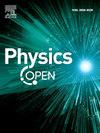First-principles investigation of NaGeX3 (X = Cl, Br, I) perovskites for eco-friendly photovoltaic and optoelectronic applications
Q2 Physics and Astronomy
引用次数: 0
Abstract
Cubic-structured perovskite compounds used in solar cells, made without lead (Pb) or other harmful materials, are becoming increasingly important as photovoltaic systems gain commercial viability. This investigation models the structural, mechanical, electronic, bonding, and optical behavior of Pb-free inorganic metal-halide cubic perovskite compounds NaGeX3 (X = Cl, Br, I) for advanced microelectronics using first-principles density functional theory calculations. The lattice constants for NaGeCl3 (5.226 Å), NaGeBr3 (5.498 Å), and NaGeI3 (5.893 Å) show excellent agreement with previously published data. The studied compounds are semiconductors with optimized band gaps and are found to be structurally, thermodynamically, mechanically, and vibrationally stable. The sX functional was utilized to enhance the accuracy of the energy band gap calculations, resulting in significantly improved band gap values for NaGeCl3 (1.76 eV), NaGeBr3 (1.65 eV), and NaGeI3 (1.22 eV). The calculated ductility, Vickers hardness, and machinability index values exhibit the following trend: NaGeCl3 > NaGeBr3 > NaGeI3. The compounds are suited for use in photovoltaic devices such as solar cells and other optoelectronic sensor systems because they have excellent optical conductivity, a high absorption coefficient, and low reflectance. It can be considered whether germanium (Ge) could serve as a suitable substitute for Pb, given its optical properties, as Ge-containing compounds demonstrate enhanced optical absorption and optical conductivity. In accordance with a comparative assessment of the compounds' electronic, optical, and mechanical behavior, NaGeI3-based perovskite is the optimal comparative to Pb-free inorganic metal-halide perovskite semiconductor for the usage of solar cells. This investigation offers valuable insights for developing lead-free inorganic perovskites suitable for optoelectronic applications and serves as a theoretical foundation to support future experimental validation of the selected compounds for practical use.
NaGeX3 (X = Cl, Br, I)钙钛矿的第一性原理研究
用于太阳能电池的立方结构钙钛矿化合物,不含铅(Pb)或其他有害材料,随着光伏系统获得商业可行性,正变得越来越重要。本研究利用第一性原理密度泛函理论计算,模拟了无铅无机金属卤化物立方钙钛矿化合物NaGeX3 (X = Cl, Br, I)的结构、机械、电子、键合和光学行为。NaGeCl3 (5.226 Å)、NaGeBr3 (5.498 Å)和NaGeI3 (5.893 Å)的晶格常数与先前发表的数据非常吻合。所研究的化合物是具有优化带隙的半导体,并且在结构、热力学、机械和振动方面都是稳定的。利用sX函数提高了能带隙计算的精度,得到了NaGeCl3 (1.76 eV)、NaGeBr3 (1.65 eV)和NaGeI3 (1.22 eV)带隙值的显著提高。计算得到的延展性、维氏硬度和可加工性指数值呈现如下趋势:NaGeBr3祝辞NaGeI3。该化合物适合用于光伏器件,如太阳能电池和其他光电传感器系统,因为它们具有优异的光学导电性,高吸收系数和低反射率。考虑到锗(Ge)的光学性质,可以考虑锗是否可以作为铅的合适替代品,因为含锗化合物具有增强的光吸收和光导电性。根据化合物的电子,光学和机械行为的比较评估,nagei3基钙钛矿是太阳能电池使用的无铅无机金属卤化物钙钛矿半导体的最佳选择。该研究为开发适合光电应用的无铅无机钙钛矿提供了有价值的见解,并为支持所选化合物的实际应用的未来实验验证提供了理论基础。
本文章由计算机程序翻译,如有差异,请以英文原文为准。
求助全文
约1分钟内获得全文
求助全文
来源期刊

Physics Open
Physics and Astronomy-Physics and Astronomy (all)
CiteScore
3.20
自引率
0.00%
发文量
19
审稿时长
9 weeks
 求助内容:
求助内容: 应助结果提醒方式:
应助结果提醒方式:


